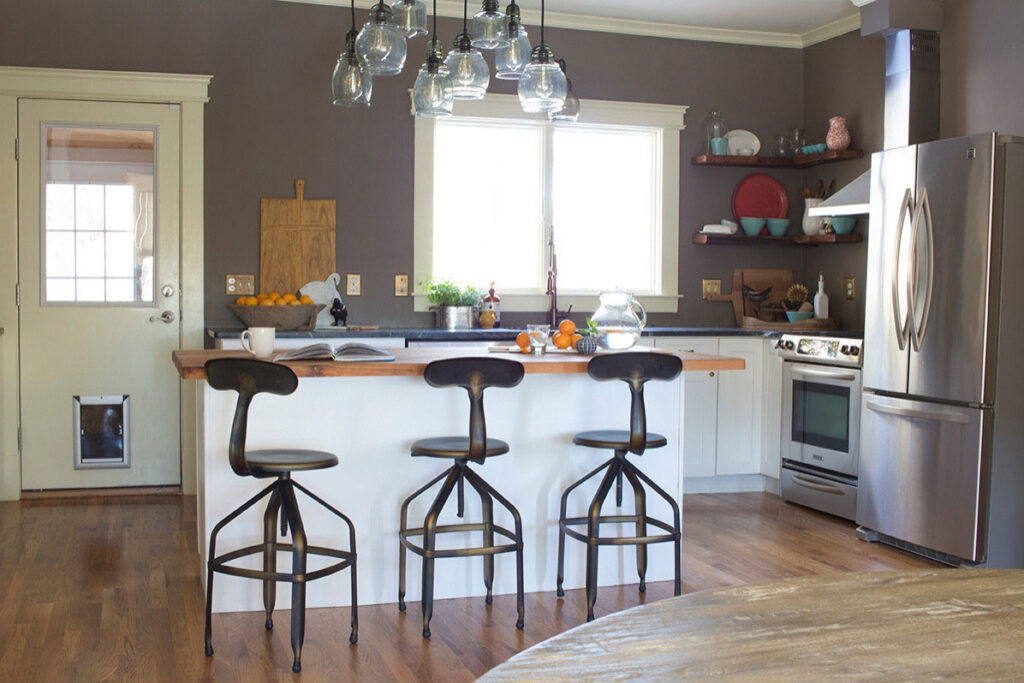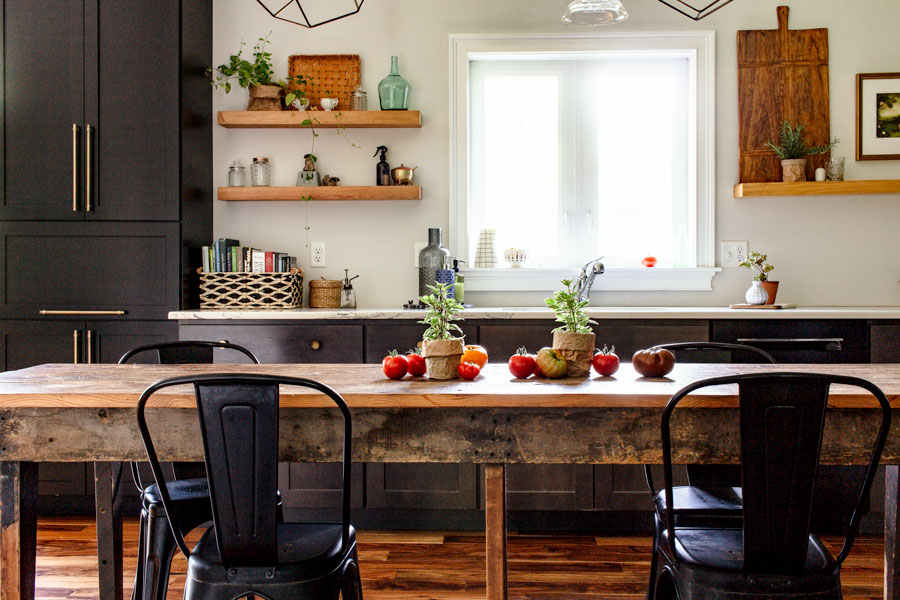Which Way Should Island Seating Face?
I absolutely adore a good kitchen island. Because let’s be honest — we live a whole lot of life in our kitchens!
A kitchen island is an essential addition to a functional, modern kitchen. They have multiple purposes such as food preparation, entertaining, working, and dining.
They’re not only functional but can be a beautiful design accent too!
One of the most important questions you may have when installing your kitchen island is which way should the seating face?

The kitchen island seating should be on the opposite side of the task space. For example, the seating should be on the opposite side of the kitchen island you use for food preparation. This works for most kitchens, but the seating may face away from the kitchen in some layouts.
There are many different ways to place your kitchen island seating to compliment the flow of your home’s layout. Depending on the dimensions of your kitchen island, you can mix and match your seating for different occasions.
For example, you could have one set up for entertaining guests and another for dining. Whichever setup you choose, the seating possibilities are endless!
Which Direction Should You Place Your Island Seating?
The most straightforward rule to follow when choosing which sides to place your seating on is that seating should always be placed opposite where the kitchen island will be used for tasks. Meaning? If you want to chat with the person on the opposite side of the kitchen island while making dinner, your back isn’t turned to them.
Facing your counter stools this way also frees up space on the seating side to eat, play games, do homework, etc. Most kitchen island seating is configured this way. This functional setup can work in larger open-plan kitchens as well as smaller, more closed-in spaces.
Check out my recently renovated kitchen to see this island seating configuration in action.
Alternative seating options
An alternative setup is the adjacent seating option. The two-sided or adjacent seating adds seats to an adjoining side of the kitchen island, creating more places for guests to sit and face one another. This seating option works well in a small kitchen where space may be too limited to place all the seating on one side.
Opposite side seating is also possible if you have a long and narrower kitchen. Placing seats on opposite ends of the kitchen island creates a cozy atmosphere for guests and makes more room on the island to serve meals.
The last two options are the three-side and four-side seating options. Placing seating on three sides of the kitchen island is the three-sided seating option. This works well with kitchen islands that have a square or rectangle shape.

The four-side seating option is not as popular and primarily used in a fixed dining setting. Or where a kitchen island is not a fixture but rather a freestanding table.
You can then place seating all around the island or table, creating space for dining but also a space for other activities during different times of the day.
This option also affords some fun styling opportunities! I have this island layout, and here’s how I decorate my kitchen for summer.
How To Choose The Best Direction For Your Island Seating?
Choosing the best direction for your kitchen island seating is a surprisingly important decision to make in your kitchen design. Placing the kitchen seating in the best place allows you to maximize the space in your kitchen. Consider a few factors in your kitchen’s design before deciding where to place your seating.
The Flow And Shape Of The Kitchen
Depending on the shape and design of your kitchen, you will need to place your seating in a place that enhances your kitchen space. Most kitchens will have seating on one side only. With more complicated kitchen designs, you may need multiple seating layouts that you can switch between depending on your needs.
The Number Of Seats You Need
A crucial question that can help determine where to place your seating is who will be seated at your kitchen island. And how many people? This may require some planning as adequate space will be needed between seats for a comfortable seating arrangement.
Generally, a minimum of 24″ in width per seat is the guideline for a comfortable seating arrangement.
The Purpose Of Your Seating Arrangement
What will your kitchen island seating be used for? Is it just for dining? Or will it be used to work from home, play games, and complete homework? Depending on your needs, you may need seating on all ends of your kitchen island.
If you use your island for food prep, you may be limited to using just one side of your kitchen island for seating. If you have a smaller space and no dining area, you might need more seats and use the island primarily for dining.
Consider Kitchen Traffic Flow
If your kitchen has lots of traffic, you’ll want to place your seating strategically to have enough space to move around. For example, don’t place seating near ovens, cabinets that will be opened, or other appliances that may need space, like refrigerators.
If your seating is close to a wall, there should be enough space to walk behind the seats without bumping into them. At least 18″ is ideal.
BTW: Have you ever considered whether your kitchen island should match your cabinets? I wrote a whole article breaking down how to mix and match finishes.
Are There Different Kitchen Seating Variations?
Kitchen island seating can be set up in many ways depending on the size and style of your island and the number of seats placed around it.
Square Kitchen Island Seating
Square kitchen islands are primarily installed in larger, spacious kitchens. They are ideal for socializing and can fit more seating than other island configurations. You can place counter stools around multiple sides of the island, so those seated are facing each other.
You can also use a square kitchen island for cooking and washing up. If you don’t want to add as much seating, you could add cabinets to one side of the island and use it for storage. Half of the seating can be placed in one direction, facing the island. In contrast, others could be placed on either side of the island for easy entertaining.
Small Kitchen Island Seating
Small kitchens can have a moveable rolling island and can be placed strategically depending on the occasion. For example, for dining, the seats can face inwards. Then, when you’re prepping food and cooking, move the island to another part of the kitchen and move the seats along the wall to keep the extra seating for guests.
Kitchen Island Seating For L-Shapes
L-shaped islands offer a generous amount of space. If you love bar-style seating, then L-shaped islands provide ample space for bar seating. In addition, the L-shape design offers a spacious workplace suitable for bigger households. You would generally place your seating facing inwards, along the long and short edges of the L-shape island.
Unique Kitchen Island Seating
If your kitchen has an unusual design, you may want to create a space that offers more seating. To do this, try adding seating on every side of your uniquely shaped kitchen island. This is the best setup for face-to-face interaction.
If your kitchen island is small, the number of seats you can place around the island will be limited. To make the most of this challenge, try placing your stools in different directions to make more space for tasks on the kitchen island.
You can also place seating against the kitchen island, with the back of the chairs facing the island. This is better for socializing if you need more seating space and guests are in the adjacent lounge.
Be sure to read my article for guidance on how to figure out the best size for a kitchen island in your space.
Conclusion
Kitchen island seating can be placed in various directions and on different sides of your island. You can move stools around depending on what you’re using your kitchen island for. The most common way to sit around a kitchen island is to have seating face the island.
Now that you have your kitchen island seating figured out, here are three easy kitchen DIYs you can do this weekend!
